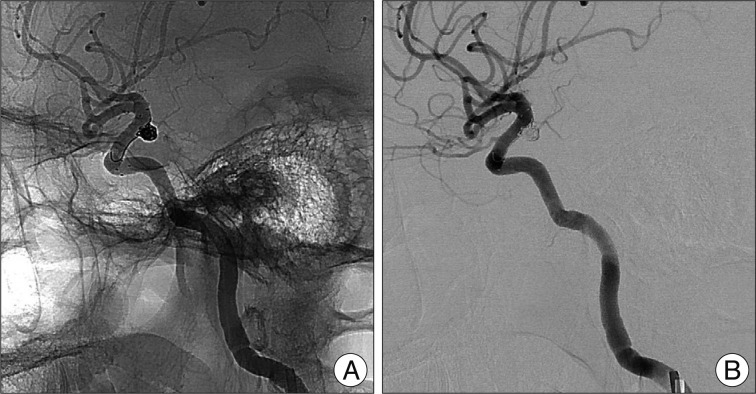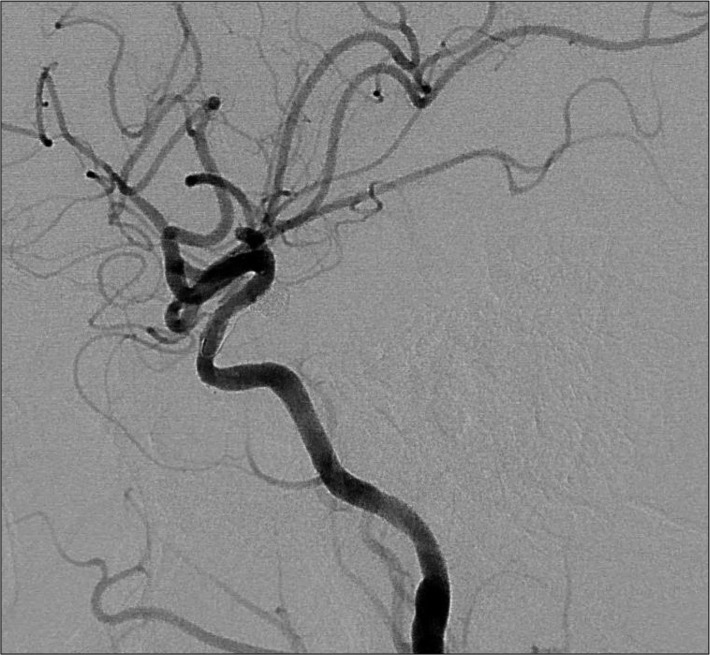J Korean Neurosurg Soc.
2012 Jun;51(6):370-373. 10.3340/jkns.2012.51.6.370.
In-Stent Stenosis of Stent-Assisted Coil Embolization of the Supraclinoid Internal Carotid Artery Aneurysm
- Affiliations
-
- 1Department of Neurosurgery, Medical Research Institute, Pusan National University School of Medicine, Pusan National University Hospital, Busan, Korea. redcheek09@naver.com
- 2Department of Neurosurgery, Medical Research Institute, Pusan National University School of Medicine, Yangsan Hospital, Yangsan, Korea.
- KMID: 2190493
- DOI: http://doi.org/10.3340/jkns.2012.51.6.370
Abstract
- The intracranial stent functions primarily to prevent protrusion of coils into the parent vessel during the embolization of wide-necked cerebral aneurysms and might also reduce aneurysm recanalization rate. In spite of these advantages, little is known about the long-term interaction of the stent with the parent vessel wall. We present a rare case of severe in-stent stenosis occurring as a delayed complication of Neuroform stent-assisted coil embolization of an unruptured intracranial aneurysm.
Keyword
MeSH Terms
Figure
Cited by 1 articles
-
Clinical and Angiographic Outcomes of Wide-necked Aneurysms Treated with the Solitaire AB Stent
Sang-Yoon Lee, Kil-Sung Chae, Seung-Jin Rho, Hak-Ki Choi, Hwa-Seung Park, Chang-Gu Ghang
J Cerebrovasc Endovasc Neurosurg. 2013;15(3):158-163. doi: 10.7461/jcen.2013.15.3.158.
Reference
-
1. Cantón G, Levy DI, Lasheras JC, Nelson PK. Flow changes caused by the sequential placement of stents across the neck of sidewall cerebral aneurysms. J Neurosurg. 2005; 103:891–902. PMID: 16304994.
Article2. Collet JP, Montalescot G. Platelet function testing and implications for clinical practice. J Cardiovasc Pharmacol Ther. 2009; 14:157–169. PMID: 19721130.
Article3. Fiorella D, Albuquerque FC, Deshmukh VR, McDougall CG. In-stent stenosis as a delayed complication of neuroform stent-supported coil embolization of an incidental carotid terminus aneurysm. AJNR Am J Neuroradiol. 2004; 25:1764–1767. PMID: 15569743.4. Fiorella D, Albuquerque FC, Deshmukh VR, McDougall CG. Usefulness of the Neuroform stent for the treatment of cerebral aneurysms : results at initial (3-6-mo) follow-up. Neurosurgery. 2005; 56:1191–1201. discussion 1201-1202. PMID: 15918935.5. Fiorella D, Albuquerque FC, Han P, McDougall CG. Preliminary experience using the Neuroform stent for the treatment of cerebral aneurysms. Neurosurgery. 2004; 54:6–16. discussion 16-17. PMID: 14683536.
Article6. Fiorella D, Albuquerque FC, Woo H, Rasmussen PA, Masaryk TJ, McDougall CG. Neuroform in-stent stenosis: incidence, natural history, and treatment strategies. Neurosurgery. 2006; 59:34–42. discussion 34-42. PMID: 16823298.
Article7. Ismail Alhothi A, Qi T, Guo S, Shi Z, Liang F, Yang L, et al. Neuroform stent-assisted coil embolization : a new treatment strategy for complex intracranial aneurysms. Results of medium length follow-up. Neurol Neurochir Pol. 2010; 44:366–374. PMID: 20827610.
Article8. Kearney M, Pieczek A, Haley L, Losordo DW, Andres V, Schainfeld R, et al. Histopathology of in-stent restenosis in patients with peripheral artery disease. Circulation. 1997; 95:1998–2002. PMID: 9133506.
Article9. Kim M, Levy EI, Meng H, Hopkins LN. Quantification of hemodynamic changes induced by virtual placement of multiple stents across a wide-necked basilar trunk aneurysm. Neurosurgery. 2007; 61:1305–1312. discussion 1312-1313. PMID: 18162911.
Article10. Kipshidze N, Dangas G, Tsapenko M, Moses J, Leon MB, Kutryk M, et al. Role of the endothelium in modulating neointimal formation : vasculoprotective approaches to attenuate restenosis after percutaneous coronary interventions. J Am Coll Cardiol. 2004; 44:733–739. PMID: 15312851.
Article11. Lopes D, Sani S. Histological postmortem study of an internal carotid artery aneurysm treated with the Neuroform stent. Neurosurgery. 2005; 56:E416. discussion E416. PMID: 15670395.
Article12. Pride GL Jr, Horowitz MB, Purdy PD. Endovascular problem solving with intravascular stents. AJNR Am J Neuroradiol. 2000; 21:532–540. PMID: 10730647.13. SSYLVIA Study investigators. Stenting of Symptomatic Atherosclerotic Lesions in the Vertebral or Intracranial Arteries (SSYLVIA) : study results. Stroke. 2004; 35:1388–1392. PMID: 15105508.
- Full Text Links
- Actions
-
Cited
- CITED
-
- Close
- Share
- Similar articles
-
- Dual Stent-Assisted Coil Embolization for Fusiform Aneurysm Arising From Persistent Trigeminal Artery
- Total Occlusion of the Internal Carotid Artery by Subacute In-Stent Thrombosis and Subsequent Spontaneous Recanalization After Stent-Assisted Coil Embolization
- A Complicated Case of Endovascular Stent Assisted Coil Embolization of an Aneurysm
- Blood Blister-like Aneurysm Treated with Coil Embolization without Stent Assistance
- Comparison of Enterprise and Neuroform Stent-Assisted Coil Embolization of Distal Internal Carotid Artery Aneurysms: Midterm Results from a Single-Center Experience





